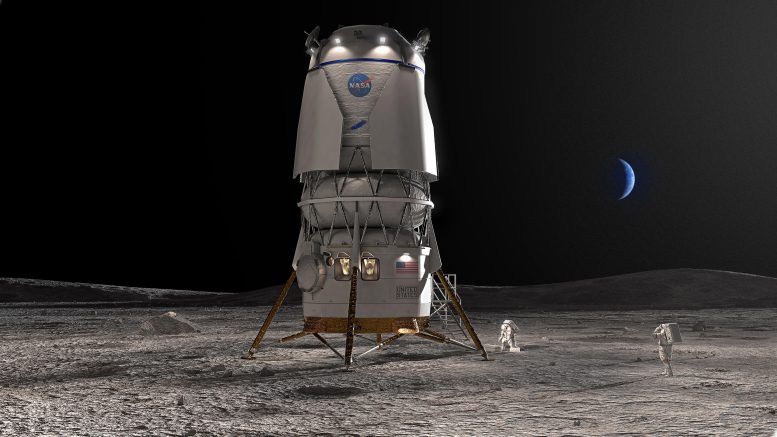
Artist’s concept of the Blue Moon lander. NASA has contracted Blue Origin to develop a human landing system for the Artemis V mission to the Moon, which is set for 2029. As part of the $3.4 billion contract, Blue Origin will design, develop, test, and verify the Blue Moon lander, which will have the capacity for recurrent astronaut missions to the lunar surface. Credit: Blue Origin
NASA has selected Blue Origin for a $3.4 billion contract to create a human landing system for the Artemis V mission, set for 2029. This move aims to spur competition, decrease costs, and support recurrent lunar landings, all while paving the way for future Mars missions.
To develop a human landing system for the agency’s Artemis V mission to the Moon, NASA has selected Blue Origin of Kent, Washington. Through Artemis, NASA will explore more of the Moon than ever before, uncovering more scientific discoveries, and preparing for future astronaut missions to Mars.
Blue Origin will design, develop, test, and verify its Blue Moon lander to meet NASA’s human landing system requirements for recurring astronaut expeditions to the lunar surface, including docking with Gateway, a space station where crew transfer in lunar orbit. In addition to design and development work, the contract includes one uncrewed demonstration mission to the lunar surface before a crewed demo on the Artemis V mission in 2029. The total award value of the firm-fixed price contract is $3.4 billion.
“Today we are excited to announce Blue Origin will build a human landing system as NASA’s second provider to deliver Artemis astronauts to the lunar surface,” said NASA Administrator Bill Nelson. “We are in a golden age of human spaceflight, which is made possible by NASA’s commercial and international partnerships. Together, we are making an investment in the infrastructure that will pave the way to land the first astronauts on Mars.”
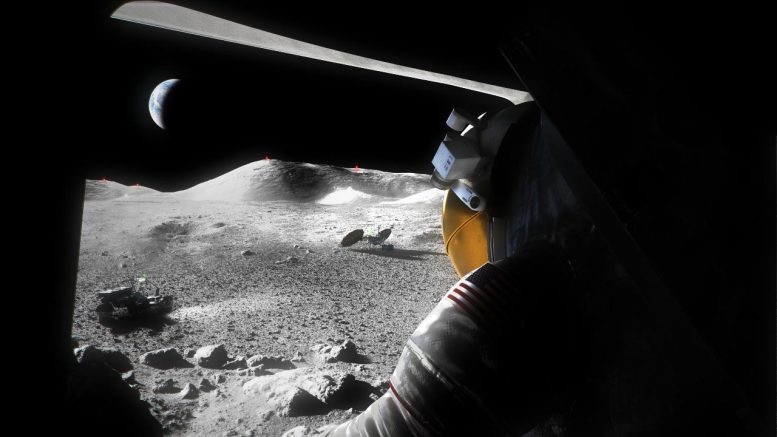
An illustration of a suited Artemis astronaut looking out of a Moon lander hatch across the lunar surface, the Lunar Terrain Vehicle and other surface elements. Credit: NASA
For the Artemis V mission, NASA’s SLS (Space Launch System) rocket will launch four astronauts to lunar orbit aboard the Orion spacecraft. Once Orion docks with Gateway, two astronauts will transfer to Blue Origin’s human landing system for about a weeklong trip to the Moon’s South Pole region where they will conduct science and exploration activities. Artemis V is at the intersection of demonstrating NASA’s initial lunar exploration capabilities and establishing the foundational systems to support recurring complex missions in lunar orbit and on the surface as part of the agency’s Moon to Mars exploration approach.
Adding another human landing system partner to NASA’s Artemis program will increase competition, reduce costs to taxpayers, support a regular cadence of lunar landings, further invest in the lunar economy, and help NASA achieve its goals on and around the Moon in preparation for future astronaut missions to Mars.
The agency previously contracted SpaceX to demonstrate an initial human landing system for the Artemis III mission. Under that contract, the agency also directed SpaceX to evolve its design to meet the agency’s requirements for sustainable exploration and to demonstrate the lander on Artemis IV. As a result of the contract with Blue Origin to demonstrate on Artemis V a lander that meets these same sustainable lander requirements, including capabilities for increased crew size, longer mission duration, and delivery of more mass to the Moon, multiple providers will be available to compete for future opportunities to fulfill NASA’s lunar surface access needs for Artemis missions.
By supporting industry’s development of innovative human landing system concepts and designs, NASA will help increase access to space for the benefit of all.
“Having two distinct lunar lander designs, with different approaches to how they meet NASA’s mission needs, provides more robustness and ensures a regular cadence of Moon landings,” said Lisa Watson-Morgan, manager, Human Landing System Program at NASA’s Marshall Space Flight Center in Huntsville, Alabama. “This competitive approach drives innovation, brings down costs, and invests in commercial capabilities to grow the business opportunities that can serve other customers and foster a lunar economy.”
NASA issued the solicitation, known as Appendix P, of its second Next Space Technologies for Exploration Partnerships Broad Agency Announcement (Next-STEP2 BAA), in September 2022 as part of the ongoing development of advanced space exploration technologies, capabilities, and concepts.
Through Artemis, NASA will send astronauts – including the first woman and first person of color – to explore the Moon for scientific discovery, economic benefits, and to build the foundation for crewed missions to Mars. Together, the SLS rocket, Orion, Gateway, advanced spacesuits, and human landing systems are NASA’s foundation for deep space exploration.


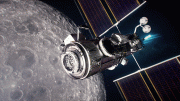
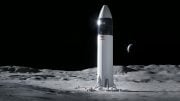

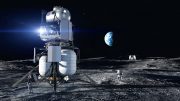
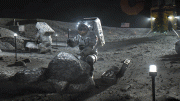


Be the first to comment on "Blue Moon Lander: NASA Taps Blue Origin for Artemis V Lunar Mission"